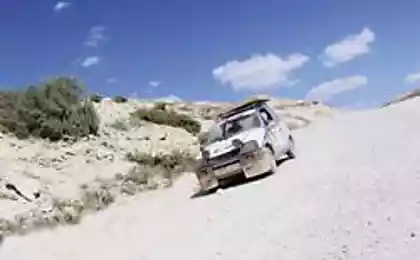454
The road Chibis
Don't shout, winged, don't worry you should not, Not, we enter it in your green garden.
See, we're guys, we're friends, birds,
And your, your not going to hurt cubesat.Anton Stranger
Remember the song about the Chibis? In Soviet times, it was the anthem of a movement of young naturalists or, for short, naturalists. Association of children and teachers who enjoy nature and studying natural-science approach in practice, it has been a long history that began in the beginning of the last century and continues to the present day. And it's not just a "social club", but a serious educational project.
Fifty two million forty six thousand one hundred eighty five
Hunters plants
The teaching of biology and related disciplines in pre-revolutionary Russia was limited by the fact that children in primary school reported some facts about nature. An in-depth study of the natural Sciences on the initiative of the teachers faced difficulties primarily ideological – it was difficult to discuss Darwin's theory in school, where in another lesson the children taught the day that God created. However, the natural-scientific worldview into schools, primarily in the Commercial College, in which the pressure of the governing bodies of education was less, and where the methodological control was weaker. The early study of natural science was raised in the community of doctors and scientists, there were new techniques developed by teachers-enthusiasts, do not lose connection with the academic environment. In 1907 was founded the Society for the dissemination of natural-history education (OREO) – the first organization in Russia, aims to popularize scientific knowledge among students and adults. One of the key methods promoted by OREO, became a biological nature excursions, as well as necessary for the realization of this idea of a tour of the station.
The first school tour the station was established by Moldenhauer in the city of Pavlovsk in 1910. It existed as a private institution on its head and worked mainly with children adjacent to the station gardeners. Summer with the boys conducted tours in the surrounding forests and meadows, sometimes these trips took all day and it was directed primarily at meaningful communication of children with nature. Subsequently, after the 1917 revolution, such stations were established quite a lot. Actually, with the change of government was associated with many hopes and aspirations among the teachers-innovators of the time. They were freed from the oppression ossified and stupid school officials, and the Marxist view better combined with the natural-scientific paradigm than the law of God.
In the first years of Soviet power really saw the rise in terms of new teaching methods, on the wave tour practice was supported by Krupskaya and Lunacharskii. In 1921 in the vicinity of Petrograd was already more than 10 tour stations that were taken over the summer, tens of thousands of children. Methodological materials for the work of guides was developed in OREO, because most of the activists of the stations was part of it. The tour stations taught not only school teachers but also renowned scholars – polar Explorer Wittenburg, botany, Atlas of the major species and Kaigorodov, hydrobiologist Deryugin, and many others. Often invited other professionals, research scientists – guests on a tour of the station came with his lectures of botany and soil scientists, zoologists and embryologists, geologists and meteorologists. For many scientists in those years working in supported Narkomprosa stations meant shelter, rations, clear position in a new constructed society. So besides the obvious pedagogical and educational sense, the biological station was of great importance for another reason – they survived and led its activities in the scientific community in the lean, difficult and generally unfavorable for science. Work in the biological stations gave the opportunity not only to teach but also conduct research, publish scientific works in the specialty.
Sixty five million fifteen thousand three hundred seventy eight
Children's demonstration in the protection of useful birds, 1934.
Classes tour bus stations was carried out as in biological disciplines including dendrology, entomology, ornithology and other subjects, such as Geology, archaeology, Ethnography, astronomy, depending on what equipment available to the station, and how circle of acquaintances possessed her head. At the Pavlovsk station was installed good at the time refractor, allowing to observe stars, there were classes on meteorology. In Strelninskoe station, formed on the basis of the yacht club had a fleet – 7 seaworthy yachts, Dinghy 3, 3 man, 2 boats and 8 ice boats. This gave the opportunity to observe sea bottom fauna and fish spawning, and at the same time to teach children the basics of sailing and Maritime training. Many stations are going to museums, native wildlife monoliths of soils, collection of lichens, mosses and fungi, Zoological angles. In Sochi the biological station Museum consisted of seven departments – Zoological, Botanical, wetland, soil, geological, archaeological and historical. A special pride of the station was insectarium with live ants showing a real anthill in cross section.
In educational projects that took place at that time on the biological stations, was attended by many famous artists – artist and architect Benoit, linguist of Bubrikh, rear Admiral hydrographer of the Swedish historian Platonov and even known to all children's writer Korney Chukovsky. But the principal organizing element of development of excursion traffic was Boris Raikov, who headed the OREO in the early 20-ies. His works began to leave the journals "Science in school" and "wildlife", there was a unified system of teaching on the biological stations, passed at the first Congress of teachers, scientists. Boris Paton has paid great attention to the transfer of experience accumulated at the stations, primary and secondary school teachers. Pavlov's and then Detskoselskiy biostation im courses were organized for school teachers for the excursions. For these courses he wrote the book "Methods and techniques of tour guiding". The work of Raikov, on the teaching of science is still considered a classic of Soviet methods of science.
Thirty two million five hundred sixty nine thousand nine hundred thirty three
His name gave the name "raikivshchyna" – a label pasted on the whole of the St. Petersburg group of teachers, scientists in 1930. The pressure on them was already a few years – they were accused of detachment from life, in opposition to the naturalists of the pioneer organization, ignoring implemented at the time of the production bias in education. In the end, Rykov was forced to leave the work to the instructor at the biological station in the Children's village, the now all-Union methodological center for training of guides, then he and his colleagues were arrested and sentenced to long terms of imprisonment, Boris Paton was on the construction of Belomorkanal. During the war he taught at Arkhangelsk pedagogical Institute, in 1945, returned to Leningrad and went back to the teaching methods of natural science. But the center yunnatskih motion moved by the time in Moscow.
The School Of Robinsons
The sad fate of the Leningrad group of teachers, scientists concerned and many of their followers. The number of biological research stations by that time numbered several hundreds, but many of them after the trial of members of the OREO were closed, the rest quickly reshaped under a new request – biology ought to immediately start to benefit the economy of the country, research is now welcomed by vegetable gardens and poultry. Excursion programme carefully designed textbooks, Museum exhibitions folded and retracted into the archive in their place came the drawings of agricultural machines, fishing nets, feed samples. In fact, the main objective of the biological stations have become the staffing of agriculture, and it was decided. Instead of qualified teachers stations often began to lead random people in education, though ideologically correct, methodical work is actually stopped.
This political battles survived and felt good Moscow Central biological station of young naturalists to them. Timiryazeva (BUSNES) in Sokolniki under the leadership of Boris all saints. Actually, with it came the reduction of "naturalists", and it is usually associated yunnatskih the beginning of the mass movement. BUSNES was since its founding in 1918, more practice-oriented than the station near Leningrad – it was cultivated vegetable garden, worked the house. On the basis of the Timiryazev biological station operated by experienced school-the colony for the homeless, which is frequented by Krupskaya. All saints were one of the activists of production, agronomic approach to teaching, so easily adapted to his school to new trends. Work on the station began to build in specific practical areas – the fight against the malarial mosquito, Surovtseva circle, a circle with the breeding of foxes. Systematic natural-scientific approach, however, when such training could not be implemented, but BYUN has released hundreds of young people who have completed their basic biological training and continuing education in this area.
Twenty four million eight hundred twenty nine thousand nine hundred six
The program of mass science education in the country continued to develop, there appeared new people and new ideas. One of the brightest figures in the movement of young naturalists was Peter Petrovich Smolin. In 1923 he organized a Club of young biologists at the Moscow zoo, a year later went out and worked for several years as a lecturer at BUSNES them. Timiryazev's. In 1930 Smolin moved to Arkhangelsk, where he founded and headed North zonal station of the all-Union Institute of fur farming. Later, in 1935, he continued his work in the Crimean natural reserve Deputy for science. There he was arrested on the denunciation, but he was more fortunate than the Leningrad teachers – his business had another change of leadership in law enforcement agencies, while checking surfaced the groundlessness of the accusations, and Smolin has been released. In 1941, he went to the militia, a good knowledge of the forest helped him in intelligence, and when out of the environment. From 1943 he taught at the courses of military dog breeding and racing pigeons.
After the great Patriotic war Smolin returned to the scientific work of the State Darwin Museum. There in 1950 he created the Club of young biologists of the youth section of the all-Russian society of nature protection, which is considered later his life. From this group came out dozens of zoologists, geneticists, ecologists, biogeographic, professors and doctors, and people who love and understand nature. The club Smolin did in his school years Nikolai Drozdov, a future presenter of "world of animals". In one of the programs he talked about his teacher: "We always competed with a circle of young biologists of the zoo. They basically watched animals in cages. We explained everything and told Pyotr Smolin, our beloved PPP. We are with him like a Tractor, went into the woods. Every Saturday or Sunday we went to the Ob Terrasny biosphere reserve is under Serpukhov on the Moscow river".
Another ruler of doom children of the postwar period was educator and writer Nikolai Verzilin – through reading his texts in biology came many Soviet schoolchildren. Nikolay Mikhailovich childhood was reading novels of Daniel Defoe, by Ernest Seton-Thompson, James Fenimore Cooper, Mayne Reid, Jules Verne, played the Indians and the Rangers, sleeping in a tent in the woods. From the age of sixteen he began teaching in a rural school and managed to infect his pupils with interest in nature, travel and adventure, took children on hikes, telling and showing them the secrets of the forest. In 1928 he graduated from the Leningrad agricultural Institute and continued to work at the school and began to teach at the Pedagogical Institute and Institute of improvement of teachers.
Forty eight million six hundred fifty four thousand three hundred twenty nine
In the beginning of the great Patriotic war, the publishing house "Children's literature" appealed to Verzilina with a proposal to write a book for schoolchildren, which could be of interest to their collection of medicinal plants. Nikolai Mikhailovich used in the text the same method as in his classes – offered to children to be in the shoes of Robinson, just happened not to be on a tropical island, and in the forest our middle band. In 1943 he published a slim pamphlet called "Clinic in the woods" which later became a Chapter of the famous book "In the footsteps of Robinson" that has 7 editions. Pen test was more than successful, and in 1949 the next biological Verzilina bestseller – "Travel with house plants", followed by a whole series of books dedicated to travel through the forests and parks in the world. Books Nicholas Mikhailovich was subsequently translated and published in Bulgaria, Brazil, Georgia, China, Latvia, Lithuania, Moldova, Poland, Romania, Ukraine, Czech Republic, Estonia, Yugoslavia, Japan.
The last of the Mohicans
While the Robinsons from biology to slowly survive in the woods the official program of the young naturalists were moving as usual. It had an impact all the zigzags of Soviet policy from the persecution of genetics, when the patron yunnatskih movement was notorious Trofim Lysenko, until the next burst of practicality in the 80-ies, when the main thing in any young nature-lover was announced, raising rabbits at home and deliver the meat to the state. Gradually, the structure of young naturalists was costinel, formalized as the pioneer organization, like many other educational initiatives in the USSR. And when this country did not, the majority of educational projects and programs initiated in it, and all came to naught.
The last stronghold of the natural-scientific works for students in the Leningrad remained established in 1964, the Laboratory of ecology of marine benthos, founder and head of which was Eugene A. Nienburg. Continuing the pedagogical traditions of the school OREO, this unique person, who had no scientific titles and degrees, has managed to grow several generations of professional researchers. In his life is also not without dramatic twists – in 1966, he was forced to resign from the Zoological Institute in connection with the fabricated "dissident". But, despite the "unreliability", it was immediately invited to a special boarding school with chemistry and biology at LSU, knowing his talent for working with children, and that was for many years his main occupation. The basis of the pedagogical method of Nienburg was kid expedition on the White sea, in which the students performed completely adult studies, learning to take responsibility for Junior associates and the General result. Through Maritime expeditions of the laboratory were more than 400 children, over 100 of them went on to become biologists, many invertebrate zoologists. Due to the fact that Yevgeny Aleksandrovich handed over leadership of the lab to his disciples, and the last years of his life remained in her teacher, expeditions and scientific work with students is not stopped when Eugene Nienburg did not. On account of the lab, more than 70 expeditions to the shores of White, Black, Barents, Azov and Baltic seas, her work continues to the present day.
Two million nine hundred six thousand one hundred eighty five
Ninety two million thirty two thousand two hundred thirty one
Many other clubs yunnatskih the efforts of educators-enthusiasts are still alive, there is a Federal children's ekologo-the biological centre, which is the successor of BYUN them. Timiryazeva and coordinating the activities of the circles of environmental and biological orientation in further education throughout Russia. However, in 2014 Sergey Shoigu said about the need to revive yunnatskih movement in Russia. Indeed, if we talk about yunnatskih educational program, it can't just be continued, have to recreate as many of the Soviet traditions have been cut short.
One of the serious problems, which is now spoken in connection with the revival movement of young naturalists – a search for scientists working on issues at the forefront of biology, and at the same time, ready to work with children. Now of the remaining units, the more education the more, the more cluttered a pile of documents, formalities, requirements for teachers, the premises and the organization of classes. The free space created by the best of yunnatskih clubs, not fit into this framework, and to adapt to the bureaucratic stupidity of those who could actually do research with students, there is no desire, and sometimes opportunities – for example, if classrooms and laboratories at the University do not meet the requirements of additional education. There is another circumstance that is not conducive to the popularity in intellectual circles at present. This younger generation faces in his life with the collective forms of thought and creativity, children are more focused on a lonely seat, than a club of like-minded people with some, for example, a Museum or the zoo.
However, if there are enthusiastic people like Smolin or Peter Eugene Nienburg, and they will create acceptable conditions for work with children, there will be students who are interested in a living, breathing exploration of the world. How knows, maybe if lovers and explorers of nature not to be disturbed, even after a hundred years in the suburbs again, they will frolic near the road Lapwings on Earth will forget about environmental issues, but on Mars, bloom tree? published
P. S. And remember, only by changing their consumption — together we change the world! ©
Join us in Facebook and in Vkontakte, and we're Classmates
Source: erazvitie.org/article/u_dorogi_chibis
See, we're guys, we're friends, birds,
And your, your not going to hurt cubesat.Anton Stranger
Remember the song about the Chibis? In Soviet times, it was the anthem of a movement of young naturalists or, for short, naturalists. Association of children and teachers who enjoy nature and studying natural-science approach in practice, it has been a long history that began in the beginning of the last century and continues to the present day. And it's not just a "social club", but a serious educational project.
Fifty two million forty six thousand one hundred eighty five
Hunters plants
The teaching of biology and related disciplines in pre-revolutionary Russia was limited by the fact that children in primary school reported some facts about nature. An in-depth study of the natural Sciences on the initiative of the teachers faced difficulties primarily ideological – it was difficult to discuss Darwin's theory in school, where in another lesson the children taught the day that God created. However, the natural-scientific worldview into schools, primarily in the Commercial College, in which the pressure of the governing bodies of education was less, and where the methodological control was weaker. The early study of natural science was raised in the community of doctors and scientists, there were new techniques developed by teachers-enthusiasts, do not lose connection with the academic environment. In 1907 was founded the Society for the dissemination of natural-history education (OREO) – the first organization in Russia, aims to popularize scientific knowledge among students and adults. One of the key methods promoted by OREO, became a biological nature excursions, as well as necessary for the realization of this idea of a tour of the station.
The first school tour the station was established by Moldenhauer in the city of Pavlovsk in 1910. It existed as a private institution on its head and worked mainly with children adjacent to the station gardeners. Summer with the boys conducted tours in the surrounding forests and meadows, sometimes these trips took all day and it was directed primarily at meaningful communication of children with nature. Subsequently, after the 1917 revolution, such stations were established quite a lot. Actually, with the change of government was associated with many hopes and aspirations among the teachers-innovators of the time. They were freed from the oppression ossified and stupid school officials, and the Marxist view better combined with the natural-scientific paradigm than the law of God.
In the first years of Soviet power really saw the rise in terms of new teaching methods, on the wave tour practice was supported by Krupskaya and Lunacharskii. In 1921 in the vicinity of Petrograd was already more than 10 tour stations that were taken over the summer, tens of thousands of children. Methodological materials for the work of guides was developed in OREO, because most of the activists of the stations was part of it. The tour stations taught not only school teachers but also renowned scholars – polar Explorer Wittenburg, botany, Atlas of the major species and Kaigorodov, hydrobiologist Deryugin, and many others. Often invited other professionals, research scientists – guests on a tour of the station came with his lectures of botany and soil scientists, zoologists and embryologists, geologists and meteorologists. For many scientists in those years working in supported Narkomprosa stations meant shelter, rations, clear position in a new constructed society. So besides the obvious pedagogical and educational sense, the biological station was of great importance for another reason – they survived and led its activities in the scientific community in the lean, difficult and generally unfavorable for science. Work in the biological stations gave the opportunity not only to teach but also conduct research, publish scientific works in the specialty.
Sixty five million fifteen thousand three hundred seventy eight
Children's demonstration in the protection of useful birds, 1934.
Classes tour bus stations was carried out as in biological disciplines including dendrology, entomology, ornithology and other subjects, such as Geology, archaeology, Ethnography, astronomy, depending on what equipment available to the station, and how circle of acquaintances possessed her head. At the Pavlovsk station was installed good at the time refractor, allowing to observe stars, there were classes on meteorology. In Strelninskoe station, formed on the basis of the yacht club had a fleet – 7 seaworthy yachts, Dinghy 3, 3 man, 2 boats and 8 ice boats. This gave the opportunity to observe sea bottom fauna and fish spawning, and at the same time to teach children the basics of sailing and Maritime training. Many stations are going to museums, native wildlife monoliths of soils, collection of lichens, mosses and fungi, Zoological angles. In Sochi the biological station Museum consisted of seven departments – Zoological, Botanical, wetland, soil, geological, archaeological and historical. A special pride of the station was insectarium with live ants showing a real anthill in cross section.
In educational projects that took place at that time on the biological stations, was attended by many famous artists – artist and architect Benoit, linguist of Bubrikh, rear Admiral hydrographer of the Swedish historian Platonov and even known to all children's writer Korney Chukovsky. But the principal organizing element of development of excursion traffic was Boris Raikov, who headed the OREO in the early 20-ies. His works began to leave the journals "Science in school" and "wildlife", there was a unified system of teaching on the biological stations, passed at the first Congress of teachers, scientists. Boris Paton has paid great attention to the transfer of experience accumulated at the stations, primary and secondary school teachers. Pavlov's and then Detskoselskiy biostation im courses were organized for school teachers for the excursions. For these courses he wrote the book "Methods and techniques of tour guiding". The work of Raikov, on the teaching of science is still considered a classic of Soviet methods of science.
Thirty two million five hundred sixty nine thousand nine hundred thirty three
His name gave the name "raikivshchyna" – a label pasted on the whole of the St. Petersburg group of teachers, scientists in 1930. The pressure on them was already a few years – they were accused of detachment from life, in opposition to the naturalists of the pioneer organization, ignoring implemented at the time of the production bias in education. In the end, Rykov was forced to leave the work to the instructor at the biological station in the Children's village, the now all-Union methodological center for training of guides, then he and his colleagues were arrested and sentenced to long terms of imprisonment, Boris Paton was on the construction of Belomorkanal. During the war he taught at Arkhangelsk pedagogical Institute, in 1945, returned to Leningrad and went back to the teaching methods of natural science. But the center yunnatskih motion moved by the time in Moscow.
The School Of Robinsons
The sad fate of the Leningrad group of teachers, scientists concerned and many of their followers. The number of biological research stations by that time numbered several hundreds, but many of them after the trial of members of the OREO were closed, the rest quickly reshaped under a new request – biology ought to immediately start to benefit the economy of the country, research is now welcomed by vegetable gardens and poultry. Excursion programme carefully designed textbooks, Museum exhibitions folded and retracted into the archive in their place came the drawings of agricultural machines, fishing nets, feed samples. In fact, the main objective of the biological stations have become the staffing of agriculture, and it was decided. Instead of qualified teachers stations often began to lead random people in education, though ideologically correct, methodical work is actually stopped.
This political battles survived and felt good Moscow Central biological station of young naturalists to them. Timiryazeva (BUSNES) in Sokolniki under the leadership of Boris all saints. Actually, with it came the reduction of "naturalists", and it is usually associated yunnatskih the beginning of the mass movement. BUSNES was since its founding in 1918, more practice-oriented than the station near Leningrad – it was cultivated vegetable garden, worked the house. On the basis of the Timiryazev biological station operated by experienced school-the colony for the homeless, which is frequented by Krupskaya. All saints were one of the activists of production, agronomic approach to teaching, so easily adapted to his school to new trends. Work on the station began to build in specific practical areas – the fight against the malarial mosquito, Surovtseva circle, a circle with the breeding of foxes. Systematic natural-scientific approach, however, when such training could not be implemented, but BYUN has released hundreds of young people who have completed their basic biological training and continuing education in this area.
Twenty four million eight hundred twenty nine thousand nine hundred six
The program of mass science education in the country continued to develop, there appeared new people and new ideas. One of the brightest figures in the movement of young naturalists was Peter Petrovich Smolin. In 1923 he organized a Club of young biologists at the Moscow zoo, a year later went out and worked for several years as a lecturer at BUSNES them. Timiryazev's. In 1930 Smolin moved to Arkhangelsk, where he founded and headed North zonal station of the all-Union Institute of fur farming. Later, in 1935, he continued his work in the Crimean natural reserve Deputy for science. There he was arrested on the denunciation, but he was more fortunate than the Leningrad teachers – his business had another change of leadership in law enforcement agencies, while checking surfaced the groundlessness of the accusations, and Smolin has been released. In 1941, he went to the militia, a good knowledge of the forest helped him in intelligence, and when out of the environment. From 1943 he taught at the courses of military dog breeding and racing pigeons.
After the great Patriotic war Smolin returned to the scientific work of the State Darwin Museum. There in 1950 he created the Club of young biologists of the youth section of the all-Russian society of nature protection, which is considered later his life. From this group came out dozens of zoologists, geneticists, ecologists, biogeographic, professors and doctors, and people who love and understand nature. The club Smolin did in his school years Nikolai Drozdov, a future presenter of "world of animals". In one of the programs he talked about his teacher: "We always competed with a circle of young biologists of the zoo. They basically watched animals in cages. We explained everything and told Pyotr Smolin, our beloved PPP. We are with him like a Tractor, went into the woods. Every Saturday or Sunday we went to the Ob Terrasny biosphere reserve is under Serpukhov on the Moscow river".
Another ruler of doom children of the postwar period was educator and writer Nikolai Verzilin – through reading his texts in biology came many Soviet schoolchildren. Nikolay Mikhailovich childhood was reading novels of Daniel Defoe, by Ernest Seton-Thompson, James Fenimore Cooper, Mayne Reid, Jules Verne, played the Indians and the Rangers, sleeping in a tent in the woods. From the age of sixteen he began teaching in a rural school and managed to infect his pupils with interest in nature, travel and adventure, took children on hikes, telling and showing them the secrets of the forest. In 1928 he graduated from the Leningrad agricultural Institute and continued to work at the school and began to teach at the Pedagogical Institute and Institute of improvement of teachers.
Forty eight million six hundred fifty four thousand three hundred twenty nine
In the beginning of the great Patriotic war, the publishing house "Children's literature" appealed to Verzilina with a proposal to write a book for schoolchildren, which could be of interest to their collection of medicinal plants. Nikolai Mikhailovich used in the text the same method as in his classes – offered to children to be in the shoes of Robinson, just happened not to be on a tropical island, and in the forest our middle band. In 1943 he published a slim pamphlet called "Clinic in the woods" which later became a Chapter of the famous book "In the footsteps of Robinson" that has 7 editions. Pen test was more than successful, and in 1949 the next biological Verzilina bestseller – "Travel with house plants", followed by a whole series of books dedicated to travel through the forests and parks in the world. Books Nicholas Mikhailovich was subsequently translated and published in Bulgaria, Brazil, Georgia, China, Latvia, Lithuania, Moldova, Poland, Romania, Ukraine, Czech Republic, Estonia, Yugoslavia, Japan.
The last of the Mohicans
While the Robinsons from biology to slowly survive in the woods the official program of the young naturalists were moving as usual. It had an impact all the zigzags of Soviet policy from the persecution of genetics, when the patron yunnatskih movement was notorious Trofim Lysenko, until the next burst of practicality in the 80-ies, when the main thing in any young nature-lover was announced, raising rabbits at home and deliver the meat to the state. Gradually, the structure of young naturalists was costinel, formalized as the pioneer organization, like many other educational initiatives in the USSR. And when this country did not, the majority of educational projects and programs initiated in it, and all came to naught.
The last stronghold of the natural-scientific works for students in the Leningrad remained established in 1964, the Laboratory of ecology of marine benthos, founder and head of which was Eugene A. Nienburg. Continuing the pedagogical traditions of the school OREO, this unique person, who had no scientific titles and degrees, has managed to grow several generations of professional researchers. In his life is also not without dramatic twists – in 1966, he was forced to resign from the Zoological Institute in connection with the fabricated "dissident". But, despite the "unreliability", it was immediately invited to a special boarding school with chemistry and biology at LSU, knowing his talent for working with children, and that was for many years his main occupation. The basis of the pedagogical method of Nienburg was kid expedition on the White sea, in which the students performed completely adult studies, learning to take responsibility for Junior associates and the General result. Through Maritime expeditions of the laboratory were more than 400 children, over 100 of them went on to become biologists, many invertebrate zoologists. Due to the fact that Yevgeny Aleksandrovich handed over leadership of the lab to his disciples, and the last years of his life remained in her teacher, expeditions and scientific work with students is not stopped when Eugene Nienburg did not. On account of the lab, more than 70 expeditions to the shores of White, Black, Barents, Azov and Baltic seas, her work continues to the present day.
Two million nine hundred six thousand one hundred eighty five
Ninety two million thirty two thousand two hundred thirty one
Many other clubs yunnatskih the efforts of educators-enthusiasts are still alive, there is a Federal children's ekologo-the biological centre, which is the successor of BYUN them. Timiryazeva and coordinating the activities of the circles of environmental and biological orientation in further education throughout Russia. However, in 2014 Sergey Shoigu said about the need to revive yunnatskih movement in Russia. Indeed, if we talk about yunnatskih educational program, it can't just be continued, have to recreate as many of the Soviet traditions have been cut short.
One of the serious problems, which is now spoken in connection with the revival movement of young naturalists – a search for scientists working on issues at the forefront of biology, and at the same time, ready to work with children. Now of the remaining units, the more education the more, the more cluttered a pile of documents, formalities, requirements for teachers, the premises and the organization of classes. The free space created by the best of yunnatskih clubs, not fit into this framework, and to adapt to the bureaucratic stupidity of those who could actually do research with students, there is no desire, and sometimes opportunities – for example, if classrooms and laboratories at the University do not meet the requirements of additional education. There is another circumstance that is not conducive to the popularity in intellectual circles at present. This younger generation faces in his life with the collective forms of thought and creativity, children are more focused on a lonely seat, than a club of like-minded people with some, for example, a Museum or the zoo.
However, if there are enthusiastic people like Smolin or Peter Eugene Nienburg, and they will create acceptable conditions for work with children, there will be students who are interested in a living, breathing exploration of the world. How knows, maybe if lovers and explorers of nature not to be disturbed, even after a hundred years in the suburbs again, they will frolic near the road Lapwings on Earth will forget about environmental issues, but on Mars, bloom tree? published
P. S. And remember, only by changing their consumption — together we change the world! ©
Join us in Facebook and in Vkontakte, and we're Classmates
Source: erazvitie.org/article/u_dorogi_chibis























